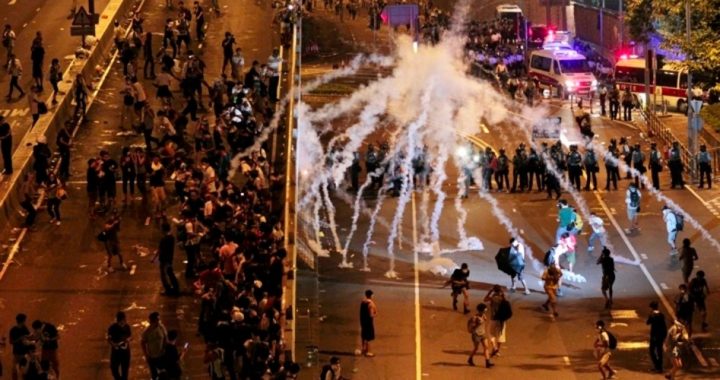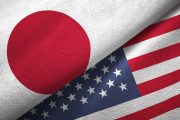
Protests in semi-autonomous Hong Kong demanding more liberty and autonomy from the Communist Chinese dictatorship ruling mainland China have been boiling over in recent days, with the regime in Beijing and its minions in Hong Kong’s government using tear gas and what critics said were heavy-handed police tactics to disperse fast-growing demonstrations. Instead of breaking up, though, the crowds grew larger.
With the communist autocracy refusing any concessions and unconfirmed rumors swirling that it may deploy its ruthless military forces to “suppress the riots,” tensions and fears are escalating quickly as well. Still, some analysts also noted that elements among the protesters, particularly self-styled “Occupy” operatives, may be acting as so-called “controlled opposition.”
Protests are a regular feature of life in Hong Kong — technically a part of Communist China after being handed over by the British in 1997, but far freer than the mainland under the “one country, two systems” regime. The latest tensions, though, have been described by numerous analysts as “unprecedented,” with widespread civil disobedience amid demands from the people of Hong Kong for a greater say in their political system.
Among other goals in what is being described as the “umbrella revolution,” protesters are seeking expanded voting rights, less interference from Beijing, and the preservation of their relatively free press and other liberties taken largely for granted in the West. Estimates suggest tens of thousands of people, at least, were out in the streets protesting.
The movement in Hong Kong to remain free from total Communist control has been strong since the island was handed over to Beijing by the British in 1997. Over the decades, mass protests against Communist Chinese meddling and oppression have become a staple. In the most recent elections, for example, huge demonstrations against Communist “brainwashing” in schools were taking place after an order that all students receive large doses of pro-Beijing propaganda dubbed “patriotic education.”
The current round of unrest began after it was announced that all candidates running for the highest political office in Hong Kong, a position known as “chief executive,” would be selected by a “committee” composed largely of pro-Beijing apparatchiks. Critics of the decision said it represented a betrayal of promises made to the people of Hong Kong, who were deceived into believing that the mass-murdering regime on the mainland would eventually grant them a greater degree of self-government and independence.
With tensions flaring, violence has now reared its head, too. Over the weekend, as the young demonstrators refused to disperse, riot police turned to tear gas, beatings with batons, and other escalated measures to break up the demonstrations. According to authorities, more than 40 people were injured, including some police officers.
Instead of persuading the outraged citizens to disperse, however, the crackdown — strongly supported by Beijing and its Hong Kong operatives — appears to have backfired. By Monday, even more protesters, enraged by the show of force, poured into the streets in response to the violence. Analysts and witnesses on the ground said the official attacks on college students and other young demonstrators led to greater numbers of older Hong Kongers joining the rallies as well.
The Communist Party dictatorship on the mainland was not amused, calling the protests “illegal” and endorsing the crackdown by Chief Executive Leung Chun-ying, who was appointed by a committee dominated by Beijing’s apparatchiks. “We believe the majority of Hong Kong residents will not tolerate a few people’s radical, illegal activism at the cost of Hong Kong’s rule of law, stability and prosperity,” the mainland regime’s Hong Kong liaison office said in a statement released on September 28.
Meanwhile, the dictatorship’s propaganda organs — especially those geared toward mainland Chinese living under full-blown totalitarianism — have been almost entirely silent about the growing protests. An order issued by Beijing’s Ministry of Propaganda obtained by media watchdogs explained why. “All websites must immediately clear away information about Hong Kong students violently assaulting the government,” the directive stated. “Strictly manage interactive channels, and resolutely delete harmful information.”
Faced with the regime’s infamous “Great Firewall of China” censorship apparatus, citizens on the mainland have instead devised other ways of sharing the news with each other. One tactic described in news reports involves sending pictures of media reports via phone to avoid being detected by the dictatorship’s text scanners. A fierce crackdown on social media is already underway as well.
Unsurprisingly, analysts said the paranoid Communist autocracy in Beijing was nervous about the growing demonstrations and the potential for further unrest. Of particular concern is that the uprising could spread to the mainland as part of a “domino effect,” experts quoted in press reports explained.
As such, the regime will use as much force as it deems necessary to contain the unrest, according to historian and political analyst Zhang Lifan. “After all, it believes that political power grows out of the barrel of a gun, instead of elections,” he told the Associated Press, citing the famous dictum by China’s mass-murdering dictator Mao Tse-tung. “It will return to this simplistic law of the jungle.”
Critics of Beijing, though, undeterred by tear gas and threats, continued lashing out at Communist efforts to tighten the noose around Hong Kong. Speaking in the city center, economist Wen Kejian said the people of the semi-autonomous territory should have a genuine choice in selecting their political leadership.
“The economy of Hong Kong has already been so prosperous and the city has been so open and international that the people of Hong Kong have the wisdom to master their political future,” Wen was quoted as saying in media reports. “Stability without freedom is slavery. It is meaningless.”
Of course, while much of the outrage against Beijing is undoubtedly genuine, some commentators have suggested that other agendas may also be at work behind the protests. Analysts at the market-oriented Daily Bell, for example, argued that the “Occupy” elements of the protest may be a sort of “controlled opposition” — especially in the United States, where the “movement” seems mostly aimed at fomenting class warfare and distracting from real issues such as the monetary system rather than upending the status-quo.
Indeed, while many media reports have painted the “Occupy” elements as the early ringleaders of the demonstrations, some of the protesters quoted in media reports argued that the “Occupy Central” operatives had actually been attempting to hijack the protests. “I came here tonight to support the students, but now I feel like I’ve been used,” 20-year-old Sharon Choi was quoted as saying. Of course, genuine angst about Beijing has been strong for decades before “Occupy” came on the scene.
As The New American reported in 2011, the “Occupy” movement was bankrolled and praised by, among other top establishment operatives, billionaire Rothschild protégé George Soros. Despite his “Open Society” propaganda, the controversial establishment bigwig, like other insiders, has become infamous for his admiration and support of the Communist Chinese regime.
In fact, in 2010, Soros came under heavy criticism for suggesting that the brutal dictatorship should eventually take over leadership of what he referred to as the “New World Order” from the United States — a talking point increasingly emanating from Beijing as well. Whether there are links between the U.S. “Occupy” crowd and the Hong Kong movement with the same name, and how deep they might go, remains unclear.
Until 1997, Hong Kong was under British protection as a colony. Britain handed control over the semi-autonomous territory to China that year and Hong Kong has managed to retain many of its freedoms thus far — a free press, the right to protest, one of the freest markets in the world, and more. The legal system also maintains many Western characteristics.
When sovereignty was transferred to the regime in Beijing, the autocrats vowed to leave Hong Kong’s traditional and long-cherished freedoms intact. The communist dictatorship even said that one day — though no earlier than 2017 to 2020 — the people would be allowed to largely govern themselves, even selecting their own leader and lawmakers.
Like most communist promises, however, it seems apparent that the guarantees from Beijing of relative autonomy and increasing self-governance for the territory and its people were a fraud. Instead, the dictatorship is increasingly seeking to clamp down on Hong Kong and its existing freedoms. However, whether the “Occupy” movement in Hong Kong represents controlled opposition to facilitate an eventual total takeover remains to be seen.
Photo of police firing tear gas on protesters in Hong Kong: AP Images
Alex Newman, a foreign correspondent for The New American, is normally based in Europe. He can be reached at [email protected]. Follow him on Twitter @ALEXNEWMAN_JOU.
Related articles:
Hong Kong Votes Amid Protests Against Beijing’s Communist “Brainwashing”
In China, Tyranny Remains 25 Years After Tiananmen Massacre
Big Soros Money Linked to Occupy Wall Street
George Soros Touts China as Leader of New World Order
Communist Chinese Regime Forcing Rural Population Into Cities
Communist China Blasts Second Amendment, U.S. Human-rights Record
China’s Churches Face Renewed Government Persecution
Remembering the Mass-murderer Mao
Mainland China’s Last 100 Years: Free Republic to Communist Tyranny



